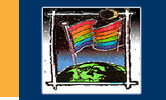Memoirs — Gens Hellquist
The Adventures of a Prairie Fag
Perceptions, The Gay & Lesbian Newsmagazine of the Prairies
Vol. 19, issue # 2, March 14, 2001.
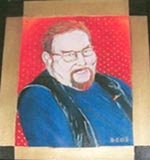 March
2001 marks the 30th anniversary of the beginning of efforts to build a gay and lesbian community in Saskatoon. While there were small groups
of gay men and other small groups of gay women going back at least to the 1920s, there were no organized initiatives to address the issues
that affected gay people until the first formal queer organization was begun in March 1971.
March
2001 marks the 30th anniversary of the beginning of efforts to build a gay and lesbian community in Saskatoon. While there were small groups
of gay men and other small groups of gay women going back at least to the 1920s, there were no organized initiatives to address the issues
that affected gay people until the first formal queer organization was begun in March 1971.
It's important for us to be aware of where we have come from and how we got to where we are today. The lessons of the past can help guide
our actions in the present and future. I have been part of the identified gay and lesbian community since I came out in 1965 at the tender
age of 19 and have been involved in establishing organizations and services in the queer community since I helped found the first queer group
in Saskatoon in 1971. This is also my 30th anniversary as a queer activist.
It has been a fascinating journey with times of sheer exhilaration and times of deep despair. I have had the honour and privilege to meet
and work with hundreds of wonderful men and women, gay and non-gay, who have toiled to build a place where all queer people are valued and
cherished.
This four-part series is a brief overview of my perceptions of Saskatoon's queer community. It is told through my eyes and others will have
somewhat different stories to tell; stories seen through their eyes. However one sees the events and issues, we all have shared in the passions
of carving out safe places for ourselves and our queer family.
Part 4
As the 1990s dawned we were still living in conservative times where money, consumption and greed seemed to be acceptable motivators for governments
and individuals. However, conservatism was starting to lose its lustre. George Bush, the Elder, seemed unable to continue the Hollywood screen
play that was Ronald Reagan's presidency and the Iron Lady, Margaret Thatcher's, hold on Britannia was starting to fade. In Canada Brian Mulroney
was still Prime Minister, tossing out perks to his cronies and in Saskatchewan the Devine government was casting an unpleasant stench over the
province. As government debt mounted under conservative rule, the ability of those conservatives to provide sound government and fiscal management
started to be questioned. The excesses of the Tories would eventually spell their demise as a political party in many parts of the country leading
to the formation of the Reform Party and the Saskatchewan Party. We can blame Mulroney for having to endure Stockwell Day.
In Saskatchewan the queer community still remained largely hidden. The Devine government had proven to be homophobic so keeping one's head down
was important for survival. As the most visible fag in the province I found myself blacklisted by the Tories and employment in the human services
sector was difficult to find throughout the 80s. I could be a liability for any organization that received funding from the province.
AIDS continued it's relentless march. By the time the new decade began numerous gay men in Saskatoon had already died from some form of opportunistic
infection that was caused by HIV and its suppression of the immune system. A number of gay men who'd migrated to the big city after their education
was completed in Saskatoon began to return home to be near their family as they died. AIDS was often a quick and efficient killer.
AIDS organizations had appeared in the major prairies cities including Saskatoon and Regina but the epidemic often seemed overwhelming. Their
initial focus was on educating gay men about the epidemic and condom use. Increasingly their energy went into providing care and support for
those who were dying. No one seemed to know how to slow the epidemic and we soon realized that a quick cure wasn't going to appear any day soon.
AIDS was here for the long run.
Governments initially were slow to react to the epidemic. After all it was just gay men who were dying, with a few unfortunate 'innocent victims'
who'd contracted the virus through blood transfusions. The federal government developed a national AIDS strategy and provided some funding for
AIDS organizations. The provincial government was even slower to react. Eventually the provincial government started to provide some funding
to AIDS groups but they often seemed to be doing it to cover their ass, 'can't lose votes on this one', instead of aggressively addressing the
issues. Unfortunately the funding never kept up to the growing epidemic and federal funds remain at the same level after a decade even though
AIDS cases have doubled in Canada.
As the decade moved forward new drugs were approved to treat the opportunistic infections that appeared after immune systems had been ravaged
by HIV. As more was learned about the virus behind the epidemic and how it was transmitted infections rates finally started to slow down. The
epidemic started to appear in other populations beyond gay men and hemophiliacs. However, gay men in North America continued to be the largest
group of people infected and dying from the disease.
By the end of the decade new treatments had been discovered the brought the disease under control for many gay men although the drugs often
had their own unpleasant side effects. However, gay men continued to become infected with HIV even though it had become clear how the virus was
transmitted. My suspicions that factors like self esteem and substance abuse complicated issues around transmission started to make sense to
some people in the AIDS movement.
In 1990 Saskatoon had no visible queer organizations. Gays & Lesbians at the U of S (GLUS) was still operating but they primarily functioned
as a social group on campus. There were a few small support groups formed around issues like religion and parenting and the Coalition for Human
Equality was still functioning although they had made little progress with the provincial Tories. Through my involvements on the board of AIDS
Saskatoon I became aware of federal government money that perhaps could be accessed to start some type of gay community organization in Saskatoon.
In the fall of 1991 I met with a few individuals who had been involved in queer community groups over the past two decades. Our preliminary
discussions with the regional population health branch of Health Canada gave us hope so we quickly put together a new organization. Bylaws were
written, an application for incorporation was sent to Regina and a grant application was sent to Health Canada. Gay and Lesbian Health Services
of Saskatoon Inc (GLHS) was born that fall. We secured a small grant the enabled us to begin a pilot project to look into the need for a queer
organization in Saskatoon that would provide support groups and education around the lives of lesbians, gay me and bisexuals.
The two year grant provided funding for two half-time positions and on November 15, 1991 Sheri McConnell and myself started our employment with
GLHS. Our first task was to find an office to rent and locate furniture and supplies to operate that office. On January 2, 1992 GLHS opened it's
doors at on the 3rd floor of 241 - 2nd Avenue S in downtown Saskatoon. The office was a dingy space on the third floor of an a largely uninhabited
office building. The space was not unfamiliar to me as it had once housed a number of small community groups and I had been up a number of times
during the '80s to talk to those groups about gay and lesbian issues. Those groups had moved on to bigger and better things. A lucky omen for
us, I hoped.
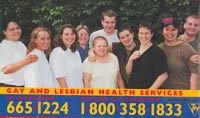
GLHS held its first volunteer training session in early February that year and soon our Gay & Lesbian Line was up and operating. We also
started Saskatoon's first queer youth group early that year and started to identify people who might be interested in forming a Parents and Friends
of Lesbians and Gays (PFLAG) group in Saskatoon. We ran a drop-in four nights a week and started the process of educating professionals and students
about the many issues that impact on the health and wellness of queer people. We also provided community development by assisting groups like
the Bridge City Chorus, gay/lesbian AA, and a group for female partners of gay and bisexual men.
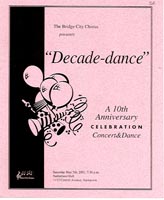
As the '90s continued GLHS experienced continual growth. As conservative governments started to fall around the world the pall of homophobia
and intolerance started to lift somewhat and more people felt safe enough to make tentative steps out of their closet. GLHS's first 2 year project
grant ended and it had clearly shown that there was a need for a group that would address the emotional, physical, mental and spiritual health
of gay men and lesbians. A second three year grant was secured from Health Canada through the HIV/AIDS division. This one was for a rural outreach
project( although we also used the grant to keep GLHS alive) that would attempt to establish support groups across the province. The only group
that still exists from that project is Lambda North in Prince Albert but they remain an active social and support group for queer people in that
area of the province.
Eventually GLHS grew beyond project status and the last project grant expired in 1996. For a few months in late 1996 and early 1997 we were
scrambling to find money to keep the dream alive. By February of 1997 GLHS was close to closing its doors. With the help of a couple of PFLAG
members, Kay Williams and Myrna Rolfes, we managed to secure core funding from Saskatchewan Health providing a more solid base from which to
operate.
The last decade has truly been one of queer liberation. The movement that began in the late 1960s achieved its largest advances in the fight
for lesbian and gay equality during the 90s. With the election of more liberal governments changes were made in human rights legislation to include
protection for sexual orientation. In 1993 the recently elected NDP government added sexual orientation to human rights legislation and most
other provinces followed suit. In Alberta the courts ruled that sexual orientation must be "read into" legislation after the human
rights laws were challenged by Delwin Vriend.
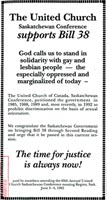
Little Sisters spent most of the decade in courts challenging Canada
Customs right to censor gay and lesbian material coming across the border. Other cases were fought and mostly won on issues that include spousal
rights, employment, adoption and marriage. By the end of the decade life in Canada for gays, lesbians and bisexuals was vastly different.
As more people came out and became visible, attitudes began to change. It was difficult to believe the myths when people you cared about and
loved disclosed that they were gay. The movement for equality now includes many non-gay people who recognize the injustice of the hate and lies.
Movies and television discovered gay characters were no longer the kiss of death and in some cases brought new audiences in. Advertisers discovered
that we were a market willing to support those who supported us. Ground breaking shows like Ellen showed queer people in more positive
lives and encouraged more people to come out. Gay and lesbian people and issues became cover stories on a wide range of magazines.
At GLHS we noticed an large upswing in calls and drop-ins after comic Ellen Degeneres came out in real life and on her television show. No longer
was it just young white middle class people coming out but a wide range of the diverse group of people who see themselves as lesbian, gay or
bisexual. The work of queer organizations has expanded to address the myriad of issues associated with being queer and living in a homophobic
society.
As the decade closed the majority of the population supported gay and lesbian rights to varying degrees. Unfortunately most gay people still
do not feel able to come out and be themselves frequently because there are still too few resources that provide support and safety on queer
issues. However, 30 years of queer liberation have changed the world.
Part 1 | Part 2 |
Part 3 | Part 4

